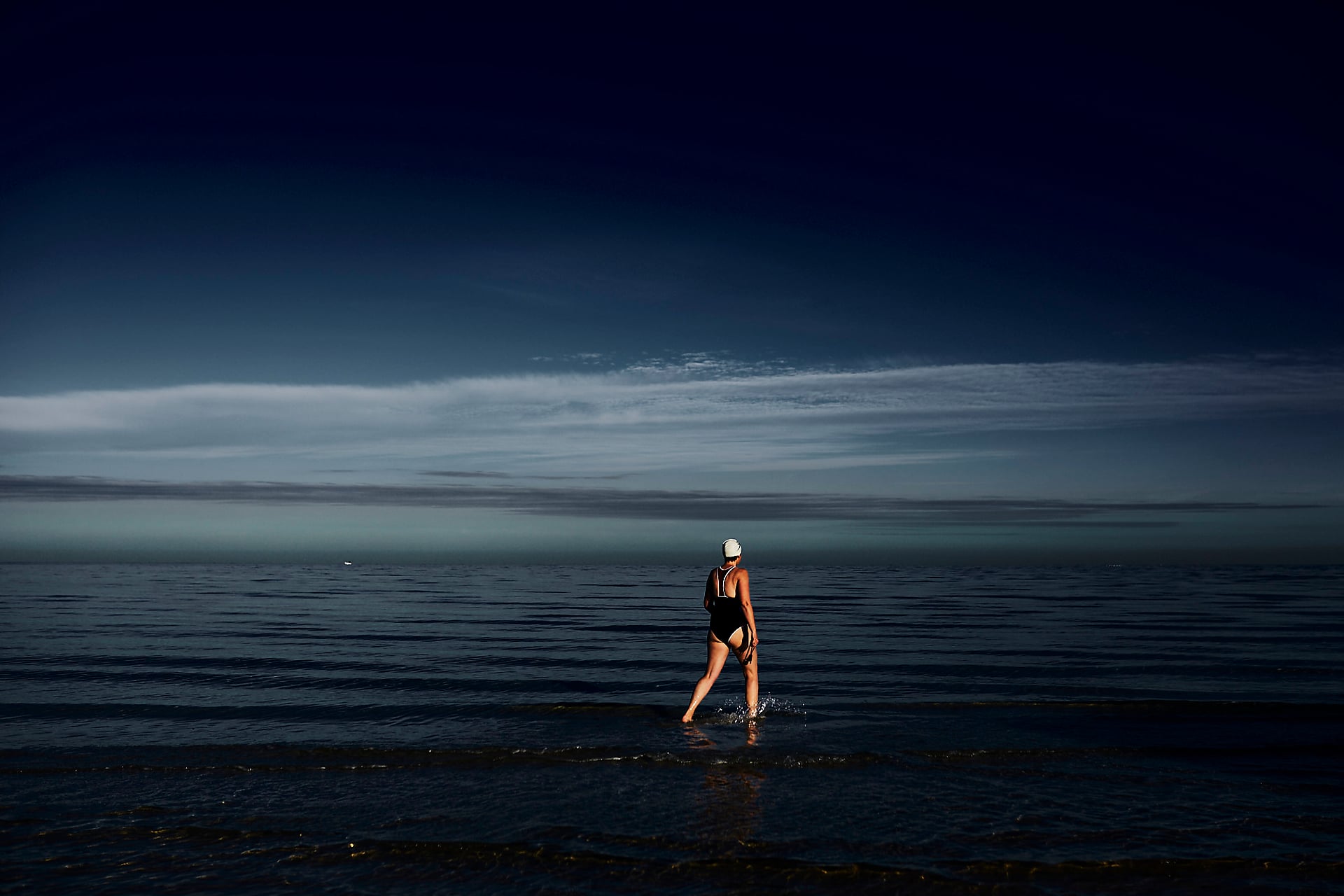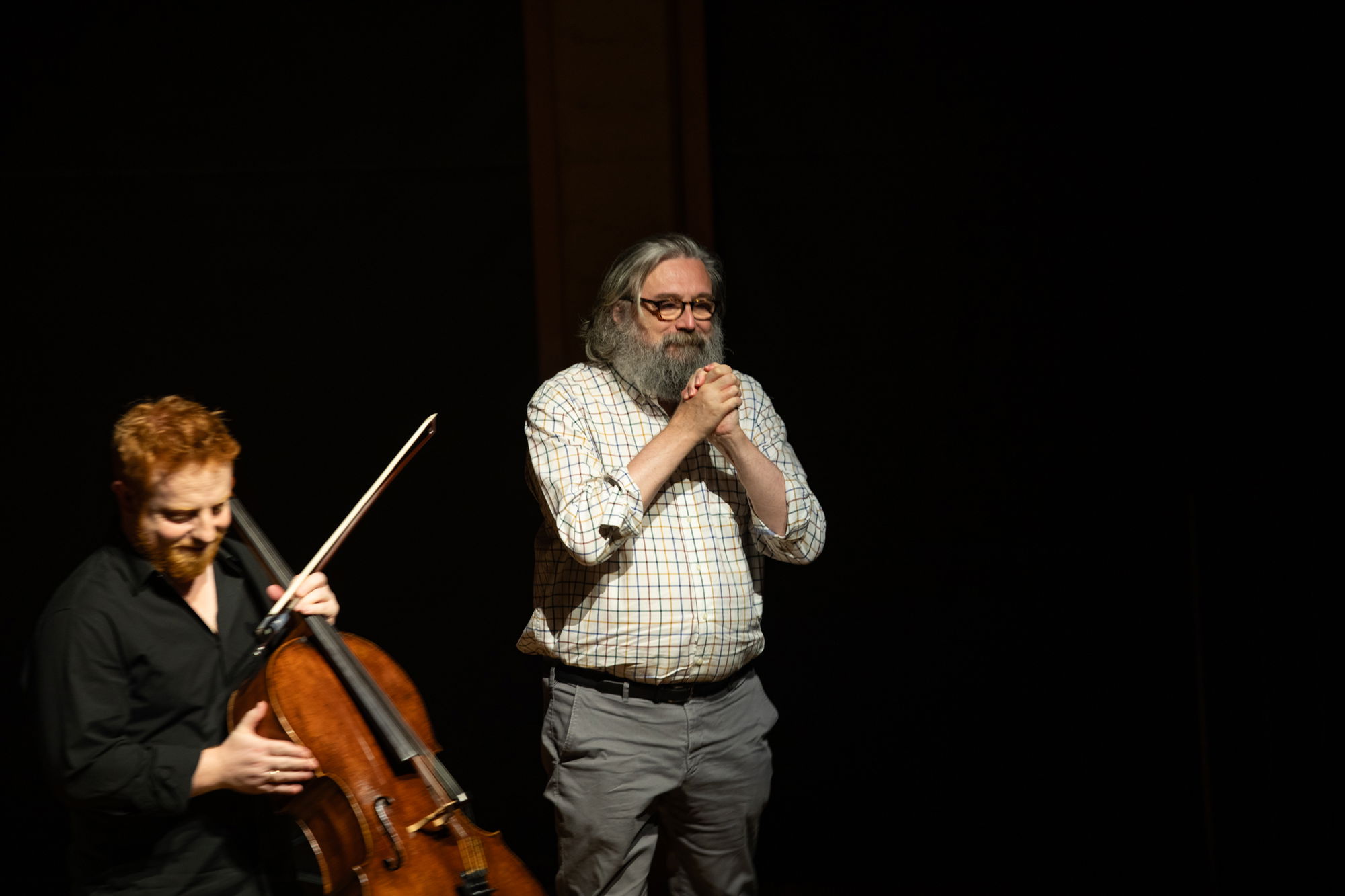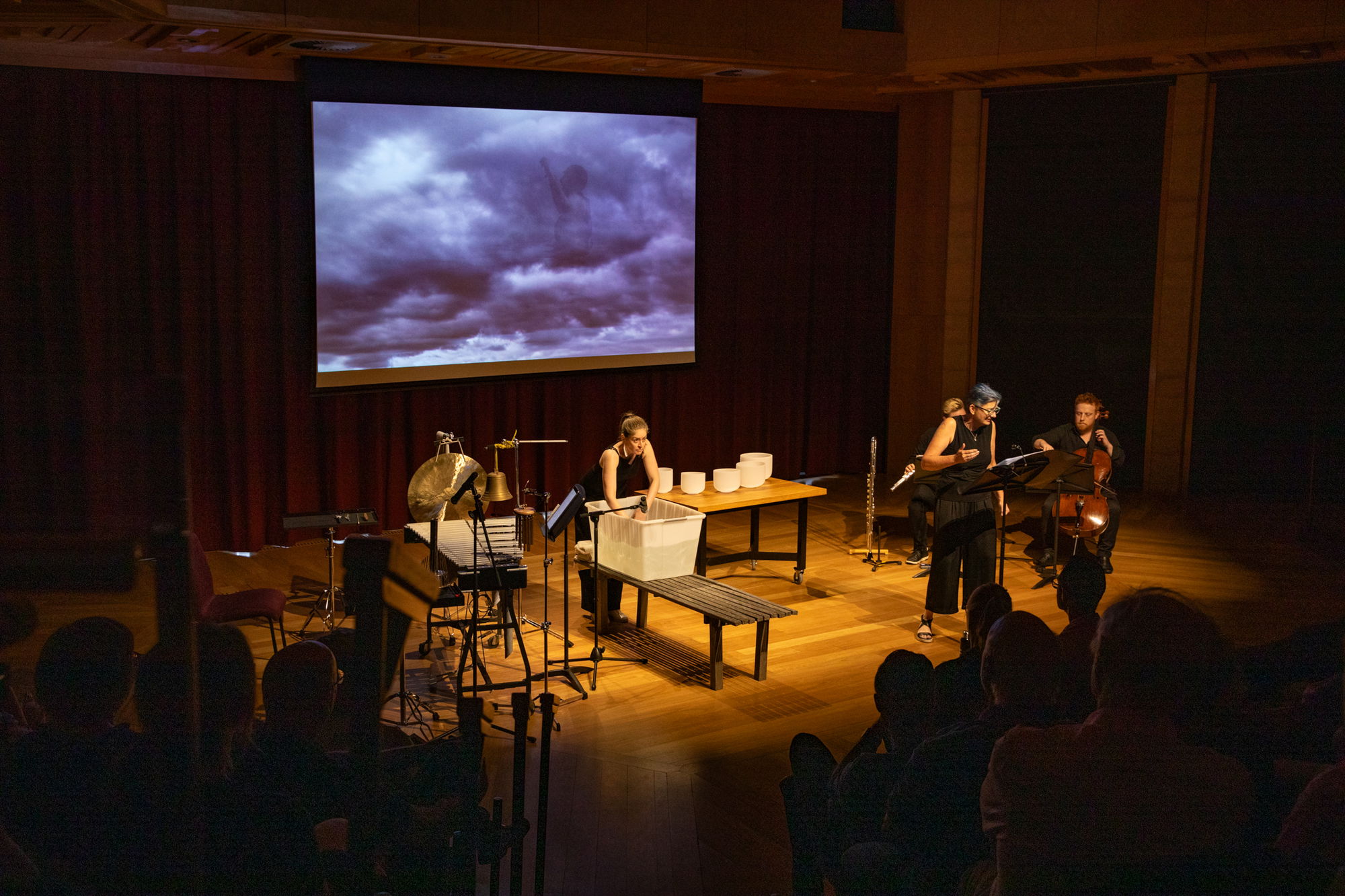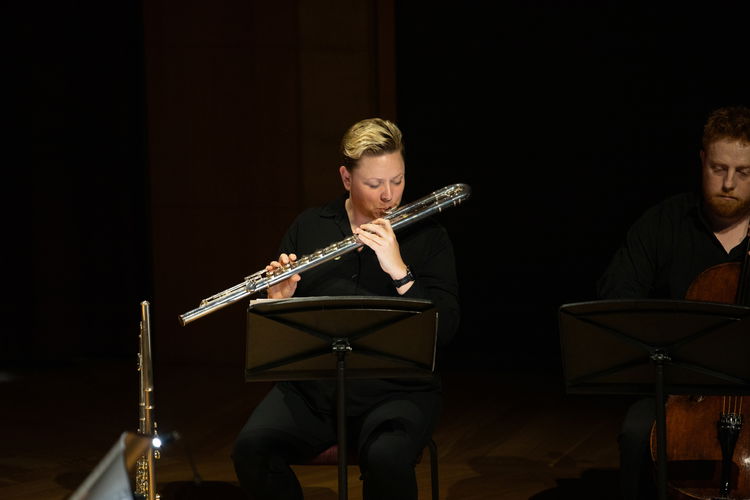
IMMUTABLE LANDSCAPES: AN INTERVIEW WITH JUDITH DODSWORTH
BY DYLAN HENDERSON
Award-winning composer Kevin March and acclaimed soprano/poet Judith Dodsworth were in residence at UKARIA from Thursday 18–Thursday 25 January, developing The Unknown Swimmer – a multi-media song cycle/theatrical work for soprano/speaker, chamber ensemble and digital environments, based on selections from Dodsworth’s anthology of the same name. The Unknown Swimmer depicts Dodsworth’s own profound transformation as she ventures into cold-water swimming to recover from a serious mental health crisis experienced during COVID restrictions and reconnect to her creativity as a response to adversity. On Friday 19 January, at the beginning of their residency, our Communications Manager Dylan Henderson spoke to Judith about cold-water swimming; the song cycle’s genesis; and where the creative team hopes to take The Unknown Swimmer next.

In the blurb you provided for this project, you describe cold-water swimming as a ‘metaphor for transformation and healing’. When did you start doing cold-water swimming, and what does it do to the human brain?
There’s growing evidence everywhere that the benefits of cold-water swimming are immeasurable for mental health, for emotional health, for physical health. A lot of people are getting on board with the whole Wim Hof ice immersion thing, and how it really recalibrates so many of our systems – it’s something that resonates with a great many people. I discovered it just prior to the COVID lockdowns in Victoria, through a very casual conversation with Jason Reekie (Jason is the photographer, working on this project). We both live by the bay, south of Melbourne, and we both like swimming, and we made a pact that we might try and swim throughout the year. It’s something that we both wanted to try – there’s various sorts of ‘iceberg’ groups around, and we had both been interested in that and admired it, and thought that at some point we’d give that a try. So we made this pact that we would swim together, and keep each other accountable, which I think helps a lot when you have an accountability buddy for anything like that!
I guess it was near the beginning of 2020, and obviously lockdowns happened, and various other things were going on. For me it was a time of some personal challenges that I needed to overcome, coupled with the restrictions that were imposed on us by lockdown. At one point we were only allowed to go within a 5km radius of home and only allowed out for one hour of exercise a day, and luckily that coincided with our regular swims, and it just became an absolute touchstone to have that routine. It ties in a lot with mindfulness as well – when you’re immersing yourself in cold water, you really can’t be thinking about anything else, so it really crystallises your thoughts and your experiences. You’re just absolutely present in a way that is incredibly helpful, I think. It certainly quietens the overactive brain!
Is that how your poetry anthology came about, or was that a pre-existing project you’d already been working on?
No, that came about through this process. Jason is a very passionate photographer, and he started bringing his camera along to document our swims, and started creating these images. When I saw them, I just thought they were absolutely stunning, and so much more than just images. There’s an immutability about the landscape – some days it would be very dark and foreboding. Yet surprisingly for a bay, the conditions are very changeable: some days it’s incredibly turbulent, some days it’s like a millpond. Seeing it recorded and reflected in Jason’s photography really sparked my imagination.
He suggested that maybe this could be a book: ‘How about you just start writing some words to go with the images, and see what they evoke for you?’ I found that once I started doing that, it just absolutely snowballed, and we ended up with a huge number of images and a lot of text to go with them. The poems were never written with the intention of being read by anyone else – let alone performed! – so it evolved very organically. We certainly didn’t set out to make a performance piece out of it. As I said, there was the thought that perhaps it could be a book, but for me it did sort of bring together different strands of my creativity. There’s something very musical in the rhythm of being in the water…
And also in the rhythms of poetry.
Absolutely.

When you were writing the poems themselves, were you thinking about how they might lend themselves to music, and if so, did you have Kevin in mind as the composer who could bring them to life?
Not consciously, but I suppose for me it’s the way my mind works – in my head I was probably singing them. There’s something beautifully linear about the way a line of text continues, which equates I suppose with the visual aspect of looking out at water. There’s something quite spiritual in that for me. Liturgical music has been part of my education and musical journey as well – traditional liturgical music, things like chant… the linear nature of that seemed to lend itself to the way the words played out. There’s definitely a singing quality, I think, in the words. Maybe on some level I thought that I would sing these words when the time is right. But it wasn’t what I’d set out to do initially – it wasn’t a conscious thing.
Did you approach Kevin, or did he approach you, to collaborate on this particular project?
I was working with Kevin online – he was needing to record some sung lines for a choral work that he was creating. I was giving him some vocal coaching online, and we both agreed that maybe we could make this a bit of a reciprocal arrangement. He said ‘I’d love to write something for you in return,’ and asked if I had any texts in mind that I was thinking of setting. It suddenly sprang to mind that maybe I could offer some texts of my own. ‘Funnily enough,’ I said, ‘I have a collection of writings which I’d be very interested in sharing with you and hearing your feedback.’ There was no expectation, but when I shared the writing with him I received a very positive response. ‘I can really hear how these would work musically,’ he said. And it’s just grown and grown from there. It was originally just going to be a short cycle of songs, but I suppose because the initial inspiration was so visual (coming from the photography), we talked about reintroducing that element. We both were keen on the idea of an immersive and multisensory experience for the audience. There’s such a multisensory quality to it, I think.
Tell us about your artistic relationship with Laila Engle, Campbell Banks, and Dr Louise Devenish. Have you collaborated with any of them before?
I’ve worked with Laila several times in Syzygy Ensemble. We’ve collaborated over the last ten years on different projects, and I find her such an adventurous, courageous performer. She’s fantastic, and she suggested Campbell, who is Syzygy’s new cellist (I haven’t actually worked with Campbell before). I worked with Louise Devenish on Cat Hope’s opera Speechless back in 2019, and I’m just absolutely humbled by this particular trio of musicians who are committed to this project. The score demands of the players something beyond just playing the notes on the page, and I think all three musicians are definitely artists who are willing to go the extra mile, extending themselves beyond their comfort zones. They’ll be participating in a number of different ways in spoken word and quite a few extra things beyond what’s on the page.
You’ve performed contemporary music at UKARIA several times now – most recently in Anthony Marwood’s UKARIA 24, and prior to that, in the Adelaide Festival. How important is it for you to have these ten days of uninterrupted time here, in this space, to work and co-create with a composer in real time?
I cannot tell you what a special thing this is! It’s extraordinary to have that immediate, real-time feedback. There’s an energy exchange that occurs when you are working with a composer in real time. The experiences that I’ve had to date at UKARIA have all been unique in their own way. Just coming to this place, you can’t help but be affected by the energy and the vibrancy, and it feels like the perfect place to explore the new and the novel – you feel so completely supported in every possible way, and it really facilitates the process. It’s an extraordinary privilege to come back here and actually have the luxury of the time and the space to try things out. It’s a place that fosters imagination and creativity in such a unique way.

You have a public presentation of the song cycle at UKARIA next week – on Wednesday 24 January – which I’m really looking forward to experiencing. What are your plans for the work after the residency? Do you hope to program the piece in an upcoming festival, or perhaps produce a recording?
We have a number of firm plans at this stage. We are presenting another preview as part of Midsummma Festival in Melbourne in early February, which is part of a concert called Homophonic! – a wonderful initiative that has been running for about fifteen years now, which presents works by LGBTQIA+ composers. I’m really looking forward to presenting it there.
We are premiering the entire work at fortyfivedownstairs
in Melbourne, as part of their Chamber Music Festival 2024: a wonderful program in early March curated by Coady Green. He’s offered us the opportunity to premiere the work there, and we’re very excited about the space that we’ll be using – I think it’s a space that very much lends itself to an immersive experience for the audience.
Because the origin of the work was very specific to a time but also to a place (Edithvale, my local beach), we have proposed to mount a performance at the Edithvale Lifesaving Club later in June, which is supported by Kingston Arts. We thought it would be really interesting to take the work out of a traditional venue and back into the community, really playing on those connections to place that we have, and hopefully attracting audiences that normally wouldn’t be coming along to a new classical music concert. We want an element of it to be accessible and transportable, so we’re really hoping it’s a work that we can travel to other places. I would love for it to become a festival work.
It has a very strong connection to the Australian landscape, too. There’s something very strongly rooted in the Australian psyche about water and the places where water and land meet: these are the places that we seek for recreation, for healing, for reflection. I think there’s something very powerful about the landscape, and the Australianness of that, that we’re hoping will resonate with people.
This residency was supported by a partnership between UKARIA and Creative Australia.




 012.jpg?class=grid1)








